
)
Expedition to Emas & the Pantanal!
Segment Five of the Great Primate Safari of 2023
(31July - 13 August 2023)
Finally I was able to return to South America and attempt to do some of the routes I had taken in the early and mid 90’s but this time with proper guides and better camera gear! And of course with a structed target list. Brazil was supposed to be my expedition in 2019 or 2020, but that tiny little virus changed everything and caused a delay. And as I aged, and time began to tick down before I have to retire and my income becomes less predictable and far less than it is today, I decided to do a major two-month expedition to three countries in South America to see as many of the amazing fauna as possible.
So with the help and expertise of Regina Ribeiro and Marluce Boute of Boute Expeditions, Xavier Munoz of Neblina Forest and Budget Rental Car, Chile, I planned for nearly a year and came up with an expedition plan that was to take me to Brazil’s Mata Atlanta (Atlantic Rainforest), Brazilian Amazona, the Cerrado and Pantanal as well as Ecuadorean Andes and Lauca, Chilean Altiplano. Of course there are too many amazing locations on the continent to put in to a short two-month expedition, we all worked hard to try to provide experiences in most of the major biomes of South America.
Since there is so much to cover from this mega-expedition, I am writing five trip reports on the links below:
Brazilian Cerrado and Pantanal
Link to complete species list for the “Great Primate Safari of 2023”
Regina and Marluce were brilliant. I initially thought about trying to do some of the trip on my own but it became very clear very quickly that I would have been a moron to try this with the limited time I had. So I approached Regina who was highly recommended by many of my mammal watching colleagues with my main target list and she took it and a few weeks later came back with an amazing itinerary that covered nearly all of what I was hoping for. The complexity of this itinerary cannot be overstated. Intimate local knowledge was necessary to know the logistics for reaching the targets’ areas while at the same time marrying complex airline schedules and road time in to the equation. This trip had so many areas where a late or canceled flight, a road closure, a prolonged storm or any unexpected impediment could have been disastrous. But after dozens of flights and transfers, there was never one instance where the itinerary was not precisely what I experienced. And out of 49 days in the field, I had 49 days of good weather!
At first glance the trip itinerary seemed a bit risky in that it allowed for very short periods of time in many of the locations where my targets could be found. Any wildlife watcher knows that it is always best to plan a couple days at least in a location to give better chances in seeing the targets. But my time frame was non-negotiable so I basically went with Regina’s and Marluce’s plan with only very minor changes rather than cut portions of the trip out completely. There were many flights involved which saved a lot of travel time. Brazil is frickin’ huge! The below map to the right shows the main destinations for my trip:
In this report, I will focus on the fauna of Brazil’s Northern and Southern Pantanal as well as the Cerrado Biome of Emas National Park, one of the most fragmented and endangered biomes on the planet.
My expedition started on 23 June, 2023 when I boarded my Qatar Airlines flight from Bangkok to Qatar and eventually to Brazil’s Guarulhos international outside Sao Paulo. Total time from door to door – BKK to GUR – 36 was hours, which included a lengthy layover in Qatar International, perhaps the largest Gucci, Louis Vitton outlet on the planet. I could barely afford a soda! I’d never seen a duty-free Ferrari before….Not sure how one takes it home – carry on? Needless to say, the travel time from Thailand to Brazil is a bit overwhelming. Pure exhaustion combined with the jetlag made spending one night in Sao Paulo the logical thing to do.

Getting ready to go!
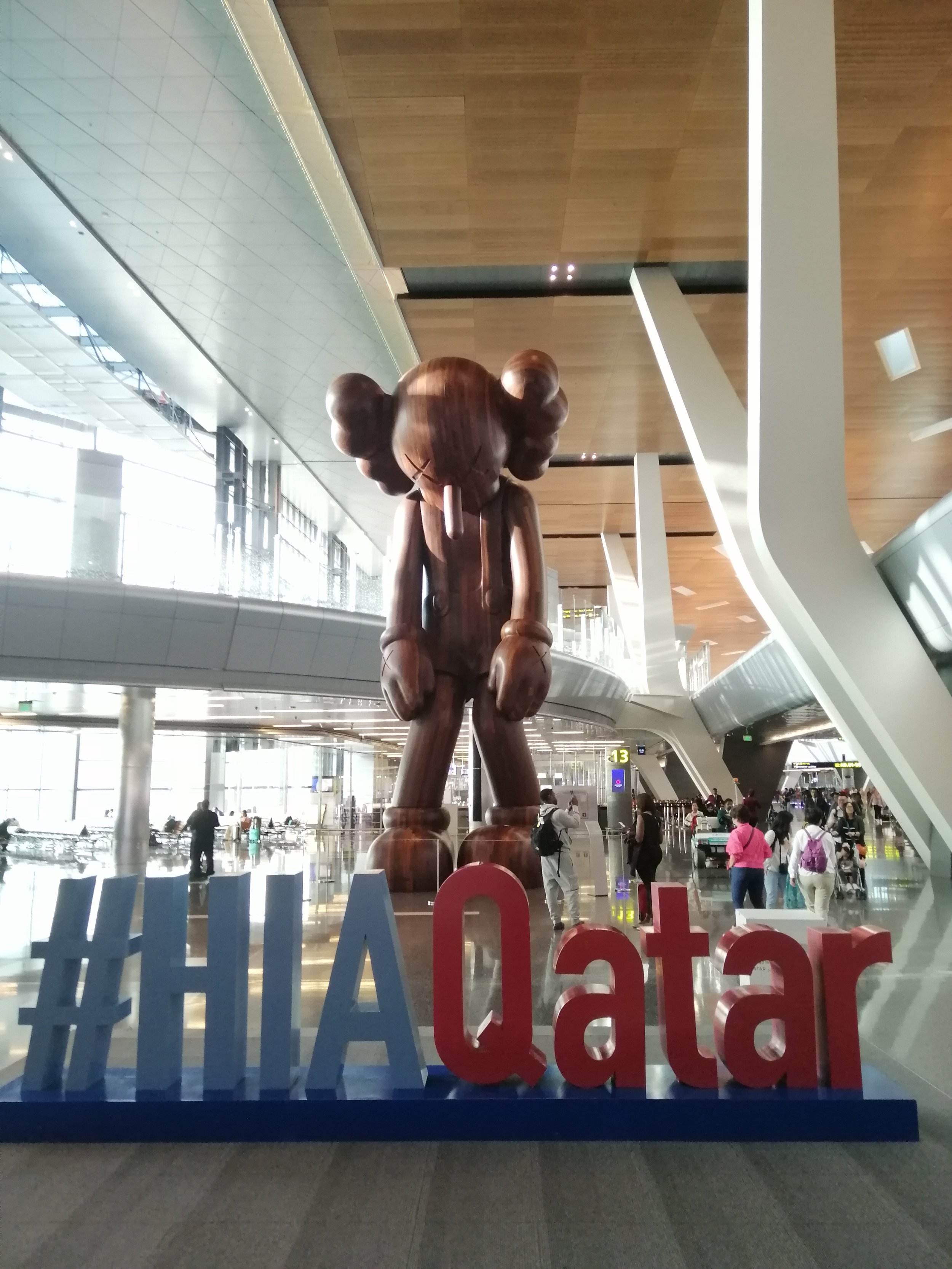
Qatar International
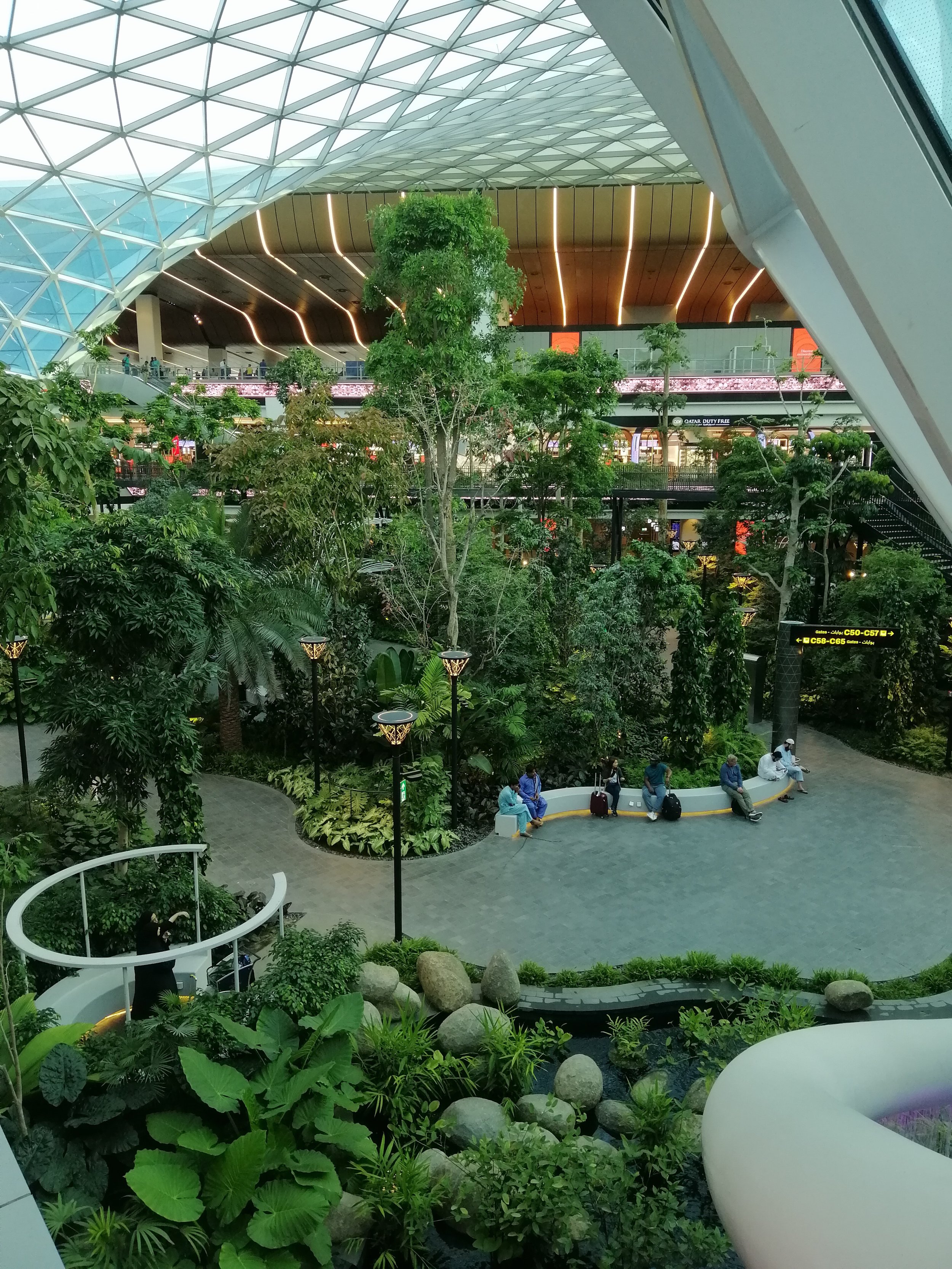
Rainforest in the Arabian desert
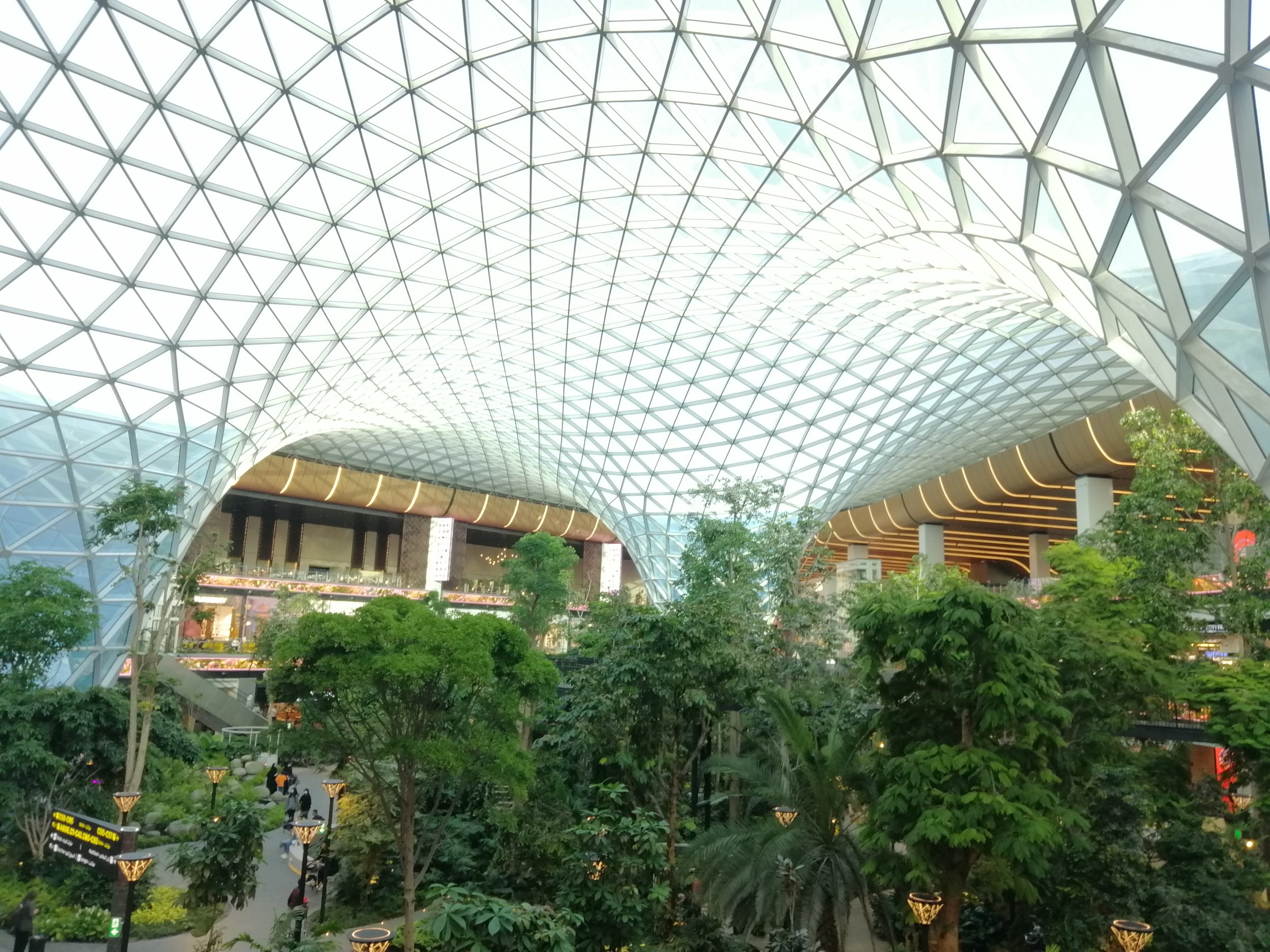

Definitely the Qatar airport is the world's largest high-end shopping mall....
Pousada Aguape
Chile was amazing, as was Ecuador, but now it was time to return to Brazil and begin exploring some of the most biodiverse habitats on the planet – the Cerrado Biome of Emas National Park and the vast Pantanal wetlands of Mato Grosso and Matto Grosso do Sul. My first stop after my long flight was Campo Grande, Brazil where I met my Guide, Marlon, who was in fact was my guide all the way through to the Pantanal and we had a blast together. Great sense of humor and a fantastic knowledge of the local fauna and where to see them.
So, the three- or so-hour drive from Campo to the Southern Pantanal was uneventful and by mid-day we made it to Aguape Lodge, perhaps the most famous of all lodges in the Pantanal. The place is simply hemorrhaging wildlife! On the drive to the lodge, we encountered no fewer than 13 individual Giant Anteaters! And by the end of day two at the lodge we counted at least 22, which far exceeded my expectations. Other species seen on the approach to the lodge include dozens of Greater Capybara and even a Red Brocket and Crab-eating Foxes.
The first thing one notices immediately after exiting your vehicle at Aguape is the number of Six-banded or Yellow Armadillos that are darting here and there all over the place. We saw at least ten or more Hyacinth Macaws and the Blue & Yellow Macaws were simply too many to count. Toco Toucans were everywhere as well. The birding is incredible there and that is the lodge’s main claim to fame for sure.
My targets for Aguape were basically the Anteaters and the Southern Tamandua, which were both very easy, although only one Tamandua was spotted. But it was such a long and quality sighting, there was no urgency for another, which surely could have been achieved. The two species of armadillo that are common there were pretty easy too – the 9-banded and the 6-banded were very quickly seen and photographed, although the 9-banded may not be guaranteed so I understand.
Collared Peccary are very common throughout the area as are feral Pigs, which come into the lodge’s feeders at night. My surprise bonus species was an awesome Brazilian Porcupine which was spotted at night along the main road sipping from a puddle. Evidently this species is very rarely seen. The river near the lodge is a good spot for Neotropical River Otters, but it took us two attempts and some hours on the river to finally see one – a leucistic one what was actually quite impressive. Along the river we spotted two to three Black Howler groups, which was one of the few NON-lifers for me on this trip.
My time at Aguape was definitely not enough. In retrospect, deducting one day at Emas for a day here may have been better, although I still feel my time in Emas was amazing. I mean, so many Maned Wolves! I would love to revisit Aguape again with at least three to four days and nights in mind.
My next destination was Emas, which was about six hours from Aguape by car.
Giant Anteater at Aguape
Collared Giant Anteater in Aguape
The long snout or rostrum up close
Females will carry their young up to 9 months or longer
Southern Tamandua
9-banded Armadillo were fairly common near Pousada Aguape
Six-banded or Yellow Armadillos were literally everywhere at the pousada. One has to watch where they step!
Little excavators!
Six-banded Tank
Crab-eating Fox at Aguape - very common
Red Brockets were common but always tough to photograph.
Leucistic Neotropical River Otter was a great lifer while at Aguape
Leucistic Neotropical River Otter
Black Howlers were quite common in Aguape
Brazilian Porcupine was a great bonus mammal at Aguape.
Capybara
Notice the giant scent gland on the rostrum of this individual.
Feral Hogs were common. This one came in for a free meal at night.
Collared Peccary were also common.
Collared Peccary
Feral Hogs
Anhinga
Chestnut-eared Aracari were common and spectacular at Aguape.
Red-crested Cardinal
Bare-faced Currasow were common in the grounds of the pousada.
Bare-faced Ibis
Plumbeous Ibis
Plush-crested Jay
Green Kingfisher
Ringed Kingfisher
Blue & Yellow Macaw were extremely common as well.
Hyacinth Macaw were also very common in the pousada.
Ferruginous Pygmy Owl
Roseate Spoonbill
Toco Toucan
White Woodpecker
Grey-cowled Wood-rail
Blue-crowned Trogon
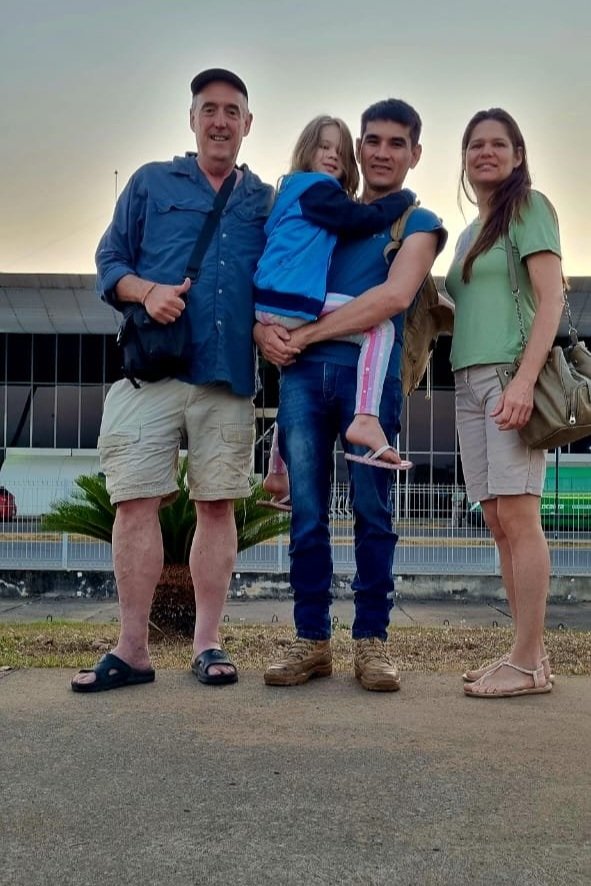
My guide Marlon and his lovely family in Cuiaba.
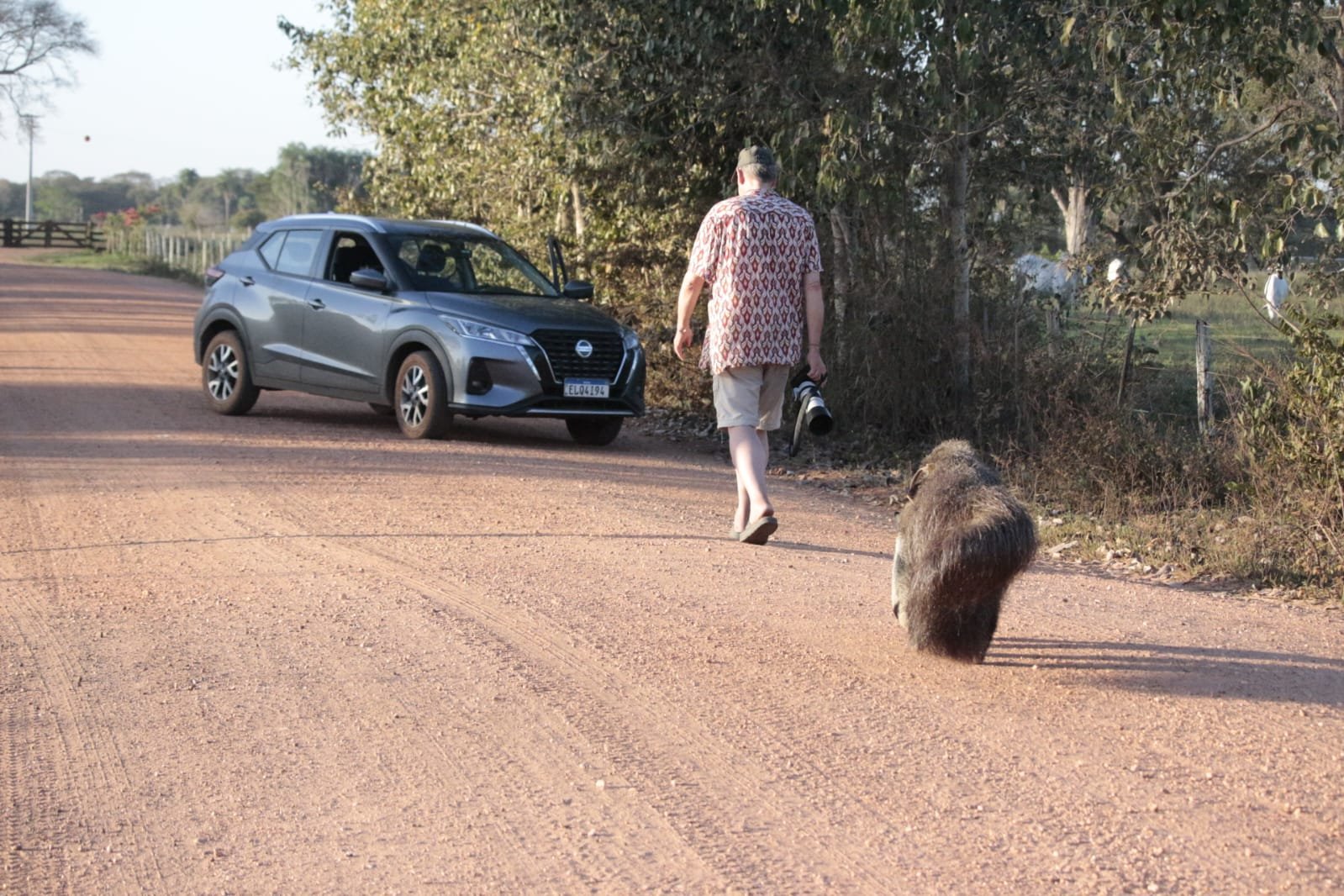
This collared anteater definitely imprinted on me. Where ever I went, he went....
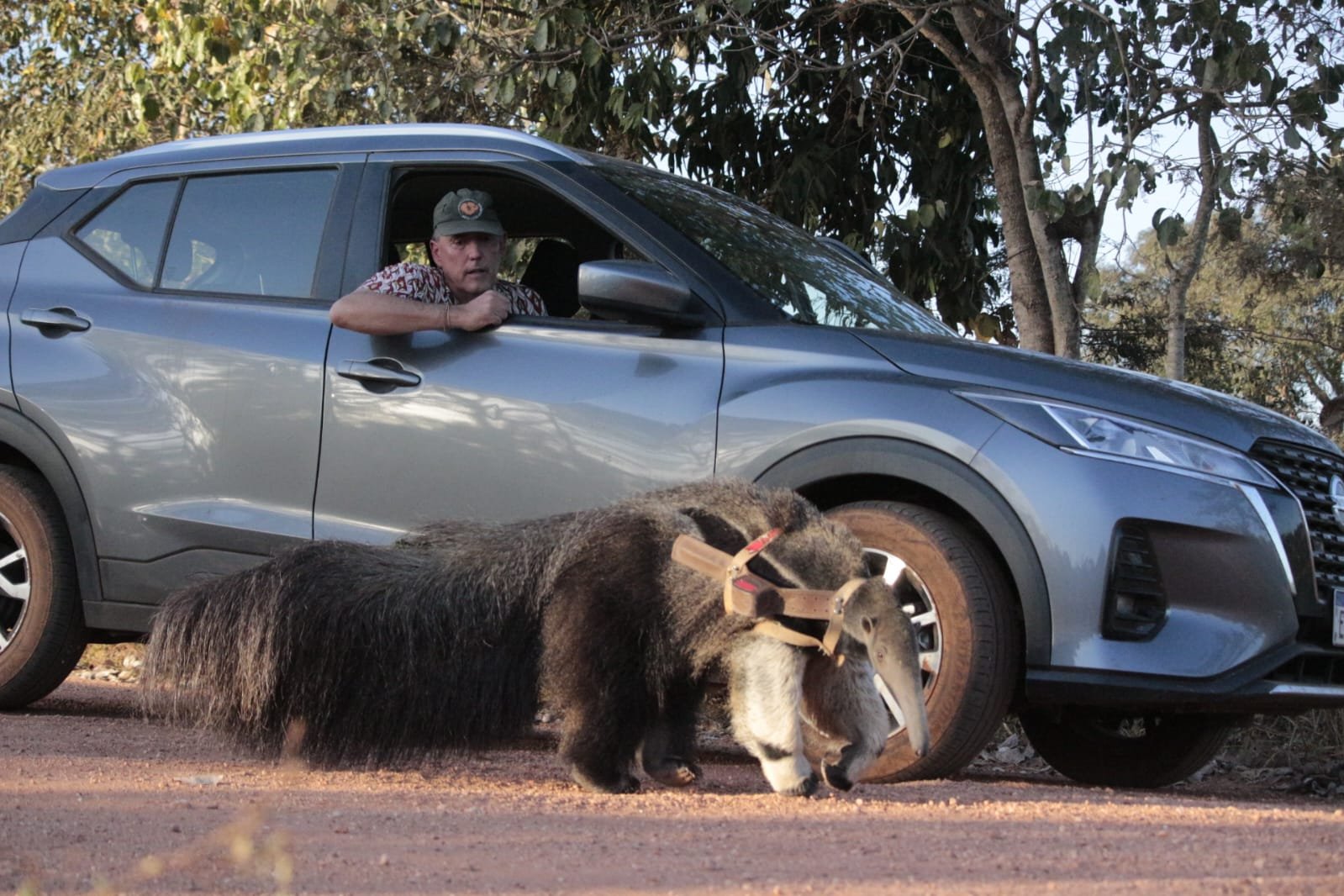
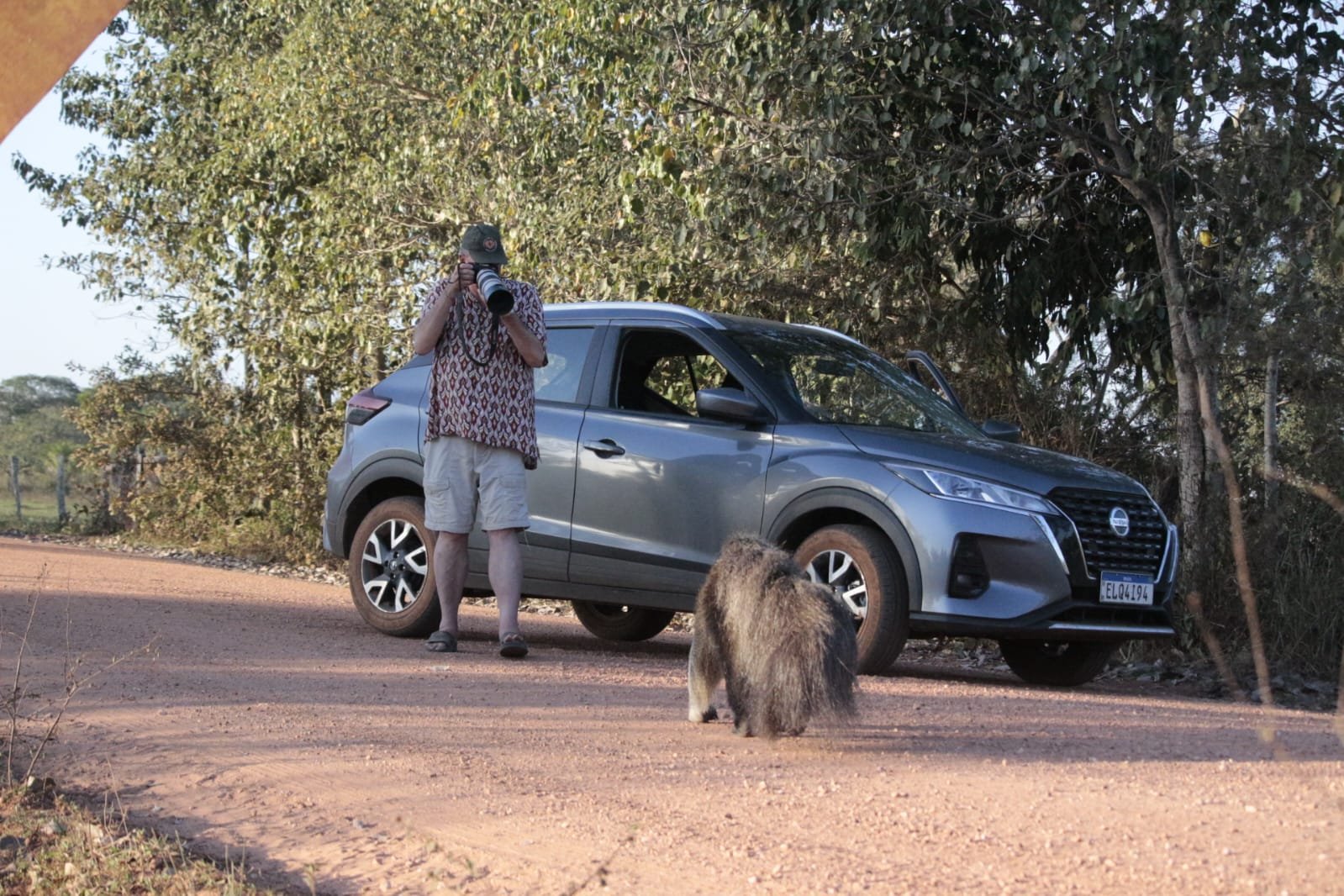
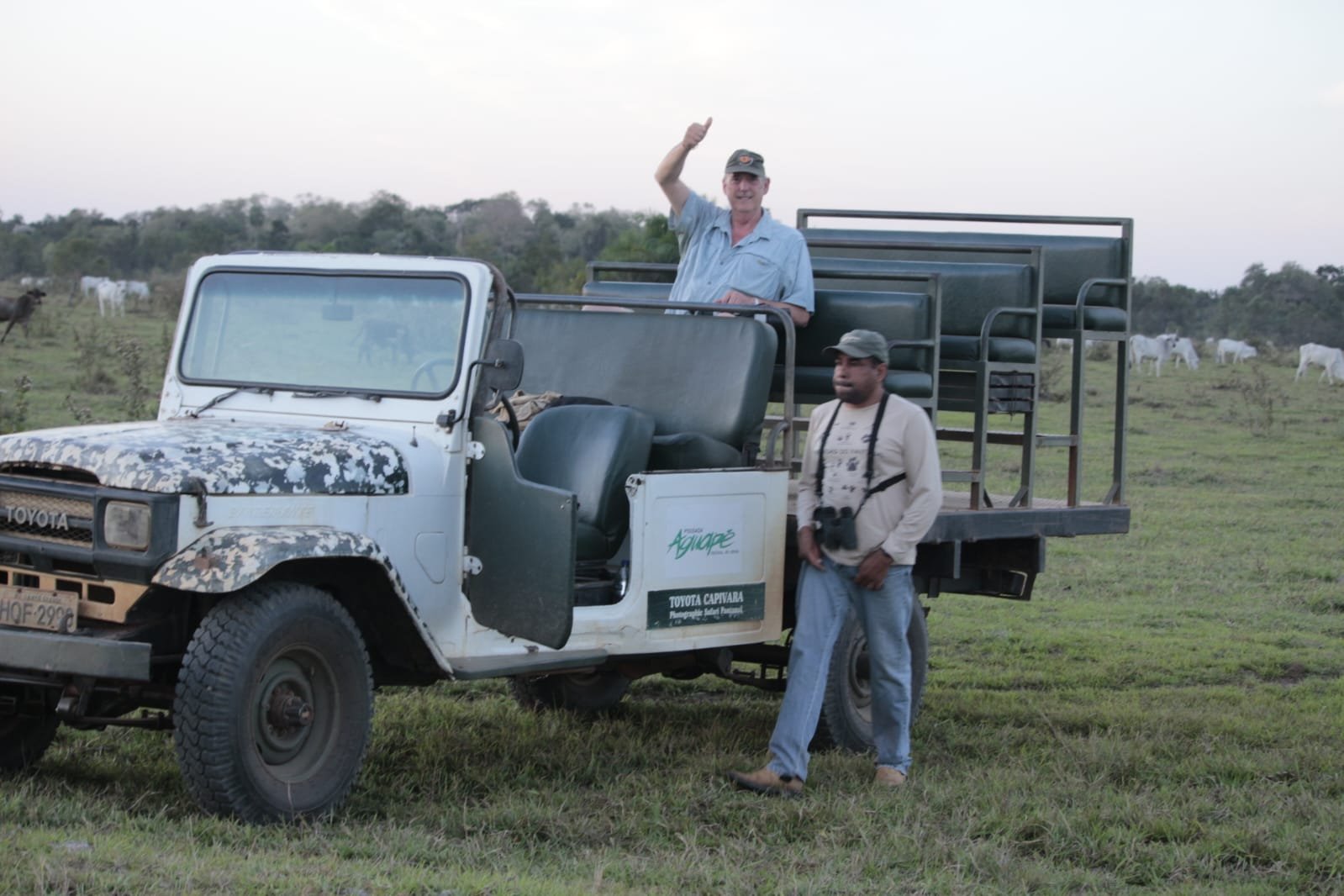
Aguape safari vehicle!
Emas National Park
While I’ve visited the Pantanal decades ago, I had never ventured in to the true Cerrado Biome before. My research long ago taught me of the place known as Emas and it was on my bucket list for years and years. Before Covid, when I was planning this trip, Emas was on my list of destinations, but I was nearly talked out of it due to the massive fire it suffered some years ago which allegedly wiped out much of its fauna. Luckily, I did not listen to this advice.
The Cerrado Biome is basically a savannah with scrublands and patches of forest punctuated by vast grasslands. Sadly, less than 20% of the original Cerrado remains and most of that is in fragments that may or may not be enough support genomes of the flora and fauna that reside within the boundaries. My drive to Emas very much illustrated this point. It is a five-hour drive from Campo to Emas and along the way we passed several small fragments of Cerrado, and the first sign of these was always large numbers of dead South American Tapirs, Giant Anteaters, Yellow Armadillos and other fauna. The situation is as tragic as it is dire for these species currently.
My local guide for Emas was Aluizio Cabral. He and his wife actually live in the reserve and their entire life has been Emas and the Cerrado, so they know an amazing amount about this region and its inhabitants. A true pleasure to be with them for my time there.
Basically, the plan for Emas was very simple – four nights and four days of hard-core game safaris around the network of dirt tracks in the park. The roads are generally very good and getting around was very easy. The main setback was the oppressive dust that our vehicle would generate, which meant that if we encountered a critter, I would need to wait a few moments for the dust to clear before a photo could be snapped. And if you were near the main road, the endless line of 18-wheelers meant that dust was a constant factor and every effort needed to be made to stay clear of that part of the park. The dust issue cannot be overstated.
Dust aside, the park is spectacular. The topography is flat with rolling hills with a few river valleys and some forest galleries that are mainly riparian in nature. The scrublands are dense in some areas and the grasslands sometimes went for miles. The park is rich in wildlife to be sure, but it is quite vast, and encounters were at times separated by quite a bit of time. Luckily, I had several days there and was able to see most of my targets, with one main exception – I dipped on Hoary Fox. Giant Anteaters was another target, but their population was truly decimated by the fire and even my local guide had not seen one in years.
My main targets for Emas were South American Tapir, Maned Wolves and Pampas Deer. All of these species were seen and seen very well on my first game drive! In fact, I lost count on how many South American Tapir we saw over the days in the reserve, and I believe that we encountered something like seven Maned Wolves! I am sure we saw at least a fifty Pampas deer in many locations throughout the reserve.
My species list at the end of my time included many other species of mammals, reptiles and birds. We spotted both species of Peccary – the White Lipped and Collared, with the White-lipped being much more common. Crab-eating Foxes were seen on pretty much all of the drives and we nailed a few Hog-nosed Skunks, most like Molina’s Hog-nosed. Azara’s Agoutis were supposed to be common in Emas, but I only managed a decent sighting of one near the main ranger station. But that ranger station is a great place to hangout as many species tend to be there as well. Azara’s Capuchins are common there too. The Argentinian Black & White Tegu are incredible!
The head ranger there, named Kennedy Road, is a wealth of information. He speaks perfect English and knows where all the good stuff is and constantly posts amazing images from the park in real time. He even showed me images of Bush Dogs taken inside Emas. Now I would go back there just for those alone!
Emas is a large fragment of the Cerrado Biome, and although considering it takes well over an hour or more to traverse the width of the park, it is still simply a fraction of what was once an amazing biome that is now filled with corn and soybeans, which is really depressing. At least someone had the foresight to set this patch aside. I’m not sure how poached the park is but I can say it does appear to be very poorly visited. During my four days in the park, I met only one other group of tourists, meaning that I basically owned Emas for 99% of the time there! Considering how dusty the roads are, I am not complaining – other vehicles would have made the experience very difficult indeed. I am very encouraged however with how much wildlife I did see during my stay so the park is definitely rebounding from the days of the fire.
Crab-eating Fox were seen on all night drives and even in the early mornings
Maned Wolf - one of many seen in Emas
Maned Wolf eathing "wolf fruit" or "wolf appled" (Solanum lycocarpum) at Emas
We spotted dozens and dozens of Pampas Deer at Emas
Argentinian Black & White Tegu were found easily at the main headquarters of the park.
Azara's Agouti are common at Emas although I saw only this individual
Brazilian Tapir were very common in Emas
Brazilian Tapir crossing the main road...hence the large numbers of road kill in the Cerrado
This Brazilian Tapir was very aggressive and demanded a handout!
White-tailed Hawk
Buff-necked Ibis
Curl-crested Jay
Southern Lapwing
Watching the Blue & Yellow Macaws squable was very entertaining!
Little Nightjar
Burrowing Owl on a termite mound
Tropical Screech Owl
The Greater Rhea, the namesake of Emas National Park (Rhea=Emas)
Red-legged Seriema were very vocal in Emas
Streamer-tailed Tyrant
Cock-tailed Tyrant

Got some White-lipped Peccaries!
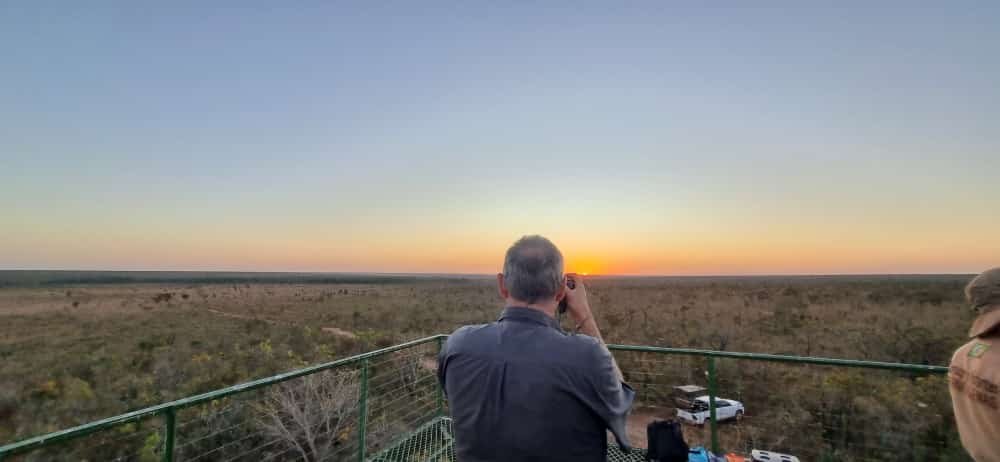
Lovely Emas sunset

Tapir damage!

Omnipresent flies...
Onward to Cuiaba
Although I flew from Campo Grande to Cuiaba, the above was my general routing for the Mato Grosso and MG do Sul segment of my expedition.
I think back to when I was just planning this expedition when I was toying with the idea of self-driving and self-guiding for the trip. My god what a mistake what would have been considering my timeline and ambitions for target species. The sheer distances alone would make such a venture absurd. Of course, I have read other trip reports of people with more time than me who had fantastic luck and great experiences, but I was simply trying to cram so much in such a small amount of time. So of course, I flew between most destinations. And considering how many flights my 54-day expedition to three countries entailed, not one was late or canceled. I consider that to be pretty miraculous.
After Emas, Marlon and I drove back to Campo for a flight to Cuiaba. A quick up and down sort of flight that left at the ungodly hour of 4AM or so but it did get us in to Cuiaba early enough to get a decent start to Porto Jofre, the end point of the famous Transpantaneira Road.
The Northern Pantanal & Encontro das Aguas State Park
The infamous busted bridge causing havoc in Porto Jofre.
Our flight to Cuiaba was basically on time and we got a fairly reasonable start toward the Northern Pantanal, the final destination for the “Great Primate Safari of 2023”. I was to spend three days and three nights at Berco Pantaneiro Lodge, which was basic but adequate.
Our route to the Pantanal is probably one of the most well-traveled routes for wildlife watchers in the world. From Cuiaba everyone makes their way to Pocone and then onward to the famous Transpantaneira road, which is an amazing 147 km dirt track that has no less than 122 wooden bridges, many of which are in very poor condition and one of which was completely ruined when we arrived! Evidently the day before two overloaded 18-wheelers went over a bridge and destroyed it requiring several days’ worth of repairs in the peak of the high season. It was pretty nightmarish. I felt pretty bad for the poor local workers and lodges who had to frantically get all of their supplies and clients and their bags across the river countless times in one or two little dingies during the time the bridge was being repaired by a very small crew of highway workers. And tourists who had less reputable guides and operators than I were forced to spend hours in the blazing sun waiting for their rides to catch them on the opposite sides of the river. It was a nightmare to be sure, although I was very minimally impacted because of the professionalism of my crew!
The trip down the Transpantaneira is not a journey for a snooze as the entire length of the road offers prime wildlife watching. I have done the trip before and spotted many species then. On this trip we spotted several bird species of interest, with the Maguari Storks being especially nice as they completed my “Seen Every Species of Stork on Earth” list! No mammals of note were seen on the way down the Transpantaneira although some nice Marsh Deer and loads of South American Coati were seen on the way back up.
There is little doubt that the main attraction for the Northern Pantanal, and Porto Jofre in particular, are the Jaguars. I’d spotted a Jag way back in 1995 but the pics were nothing to brag about, so I really wanted another opportunity to see them again now with the proper gear and time. That being said, Jags were not my only or even my main target. I was also really wanting to get better images of Giant River Otters and swimming Tapir. And of course other species such as Brazilian Cavy and Azara’s Capuchin were important to me as well. An Ocelot would be nice too, and in fact it was the very first species seen on the Transpantaneira! I got very decent images of its butt, but nothing else….
Luckily my flight was on time and the bridge debacle did not cause me to miss my first boat ride to Encontro dos Aguas State Park, home of the highest densities of Jaguars in the Americas. By three PM we were on our way down the Cuiaba River to search for wildlife. Basically, the mode of wildlifing in the Pantanal involves cruising the river system and small channels scanning the banks for whatever may be there when you pass by. There are generally dozens of other boats on the river at any given time and they are all in constant communication with each other via walkie talkies.
My first afternoon had a relatively slow start with no Jaguar or Otter sightings for almost two hours. I was feeling good because I knew I had at least two more full days on the river and my chances were good. I was enjoying simply getting the hang out of the lay of the river system and building my image catalogue of the avifauna and other interesting species.
So about two hours into the cruise, the message came through that there was a Jaguar nearby, so we sped to see if we could get a glimpse. However, seeing at least twenty boats already there made me recall my trips to India and East Africa with the big cat traffic jams… But I must admit the aquatic nature of the jams in the Pantanal made it a bit more bearable as getting decent views always seemed to be possible do to the fact that the boats could position themselves much more easily than jeeps could on a single lane dirt track like in Africa or India.
We got to the location in time to watch a spectacular female Jaguar walk the shore and eventually swim across the channel allowing awesome views of how skillful she was at swimming with absolutely no fear or hesitation of jumping right into the water. In fact we had to reposition our boat as the cat was aiming directly at us and we would have been blocking its route to the opposite shore. My first sighting ended up being my favorite for the entire three days.
So, with the Jaguar seen and photographed well, I was hoping now for Giant Otters, but that was not to happen on day one if I recall correctly. Not to worry, over the next two days, we had multiple sightings of the massive mustelids, and I was able to get some beautiful shots of them feeding on the local fish fauna. I was unable to get a full body show which I really wanted but all of the feeding shots were actually more special when I think about it.
We had many other species over the days in the Pantanal. I must be honest; I did lose count of how many Jaguars we spotted – I am pretty sure I recall it was 13 or so! A low number according to Marlon actually. They were incredibly common, and their density was truly a testament to effective conservation and an amazing supply of prey. Of course, we were there during the peak season for spotting Jags but still it was damn impressive to see so many so easily. I eventually started to turn down opportunities to see more simply to continue my pursuit of other species and photo-ops, like South American Tapirs swimming across the river! Now that was awesome!
Cruising the rivers and channels of Encontro das Aguas State Park was simply epic. There are very few places on earth left this wild. There were times when we were the only boats to be seen and they were my favorite times. We even got our own Jag while we were alone for a spell. I did not see a “kill” although there were several individuals definitely in the hunting mode, and one of our Jags actually did go for a kill a few minutes after we left. Pretty awesome but oh well.
I felt pretty good with the several thousand images I was able to capture in my short but quality time in the Pantanal. Many species of birds and even some reptiles were seen, and you can see them in the labeled image galleries. The Pantanal is insanely expensive nowadays, but it is still worth it. The time period I was there is definitely the most crowded with humanity but honestly it is manageable and tolerable, and a fantastic wildlife experience is still very possible and even probable.
Jaguars of Encontro das Aguas State Park, Northern Pantanal
Anhinga are very common in the Pantanal
Yellow-billed Cardinal
Black-capped Donacobius
Black-bellied Whistling Ducks
Great Egret
Laughing Falcon
White-throated Piping-Guan
Black-collare Hawk
Great Black Hawk
Boat-billed Heron
Capped Heron
Rufescent Tiger Heron
Green Kingfisher
Ringed Kingfisher
Snail Kite
Pied Lapwing
Southern Screamer
Black Skimmer
Jabiru
Yacare Caiman in the Pantanal
Tropidurus etheridgei - Etheridge's Lava Lizard - Porto Alegre Lodge, Pantanal
Salvator merianae - Argentinian Black & White Tegu - Pantanal, Pouso Alegre Lodge, Brazi
Iguana iguana - Green Iguana - Pantanal, Encontro das Águas State Park, Porto Jofre, Cuiaba River, Brazil
Eunectes notaeus - Yellow Anaconda - Pantanal, Encontro das Águas State Park, Porto Jofre, Cuiaba River, Brazil
Crocodilurus amazonicus - Crododile Tegu - Pantanal, Encontro das Águas State Park, Porto Jofre, Cuiaba River, Brazil
The Transpantaneira & Pouso Alegre Lodge
With my amazing days in the Encontro das Aguas State Park and Porto Jofre at an end, I finished my epic expedition at the phenomenal Pouso Alegre Lodge that is near the northern edge of the Transpantaneira Road. This is definitely a place that requires more than the one night I allowed time for. The biodiversity there is out of this world and is a great place to see my last primate target, the Black-tailed Marmoset, which was very easy to see near the lodging area.
The approach to the pousada is a long dirt track. While we were dealing with a flat, I trekked up the road a bit and immediately came up on a shy group of Azara’s Capuchin and several dozen South American Coati. I noticed several other movements in the thick brush but could not get a good look at what was making them. I knew this place was rife with critters.
Our first and only night drive surprisingly was pretty devoid of major mammal sightings aside from a few rodents scurrying across the road, only one of which I was fast enough to photograph but still with no ID. We did see fresh Jaguar sign and several felid species are known from the area. We spotted the requisite Crab-eating Foxes and tons of Capybara, as well as a few Azara’s Agouti as well.
Aside from the Azara’s Capuchin and the Black-tailed Marmosets, I also spotted what I am 99% sure are Black-striped Capuchin. Evidently the Azara’s and the Black-striped are sympatric in the area and are often found in the same general areas, although I have no idea the degree to which they hybridize.
The avifauna of the lodge property is state of the art and of course is the main draw for the tourists who frequent the lodge. I was even able to get a spread-wing shot of the legendary Sunbittern, one of the main targets for birders. I did see some distant Marsh Deer deep in the marsh lands west of the lodge down by the trail to the tower. The private lands of the pousada are massive with dozens of square kilometers that would take days to explore adequately. I highly recommend the place for mammal watchers as it allows very good views of many of the species that may be difficult to view in other locations. For example, the Coati that frequent the lodge itself are very habituated to people and allow close views without them bolting immediately out of view which was the case will all of my previous sightings in Brazil.
After a wonderful stay at Pouso Alegre, it was time to head back to Cuiaba and then onward to Sao Paulo and then 36 hours back to Bangkok via Qatar. The final stop in Cuiaba was at a popular restaurant that Marlon knew about that had a large population of the Black-tailed Marmosets. Evidently many of the forested green spaces in Cuiaba are good for the marmosets – something to keep in mind if your time is limited there. Our target was actually the Brazilian or Guianan Squirrel, which I had failed to see in any of my locations on this expedition, but as with other locations, I learned that the squirrels were very difficult indeed to see. At least Marlon gave it a try for me.
I was exhausted. I mean I was total beat. 54 days was a hell of a long haul for this 60-year-old wildlife watcher. 49 of those days were in the field – up at O-dark thirty and usually with a night safari on top of it all. Of course, I was driven. I was on a mission. Knowing one’s days are numbered can definitely give one the boost of energy or encouragement to be a bit superhuman. With my 49 field days done and well over 110 mammal taxa documented with most of the photographed and some of them well, I was beyond happy. And God only knows how many bird taxa I had by day 49… This truly was one of the best wildlife expeditions of my life and I’ve had a lot! Not as many as some people in the mammal watching community but definitely more than my fair share. What a trip!
Species List for the Northern & Southern Pantanal and Emas National Park, Brazil
Link to complete species list for the “Great Primate Safari of 2023”
Order Primates
1. Alouatta caraya - Black Howler - Pousada Aguape, Mato Grosso do Sul
2. Mico melanurus - Black-tailed Marmoset - Cuiaba Town, Mato Grosso, Brazil
3. Sapajus cay - Azara's or Hooded Capuchin - Pantanal, Cuiaba River
4. Sapajus libidinosus - Black-striped Capuchin - Porto Alegre Lodge, Pantanal
Order Pilosa – Anteaters
5. Myrmecophaga tridactyla - Giant Anteater - Pousada Aguape - Mato Grosso do Sul
6. Tamandua tetradactyla straminea - Southern Tamandua - Pousada Aguape - Mato Grosso do Sul
Order Cingulata - Armadillos
7. Cabassous unicinctus - Southern Naked-tailed Armadillo - Feliciano Miguel Abdala (Caratinga)
8. Dasypus novemcinctus - Nine-banded Armadillo - Pousada Aguape
9. Euphractus sexcinctus - Six-banded Armadillo - Pousada Aguape
Order Chiroptera - Bats
10. Noctilio albiventris – Lesser Bulldog Bat – Cuiaba River, Pantanal
11. Tadarida brasiliensis – Brazilian Free Tailed Bat - Emas
12. Glossophaga soricina - Pallas's Common Long-tongued Bat - Illeus, Bahia
13. Rhynchonycteris naso - Proboscis Bat - Pantanal, Cuiaba River
14. Trachops cirrhosus - Fringe-lipped Bat - Porto Alegre Lodge, Pantanal
Family Bovidae – Cows
15. Bubalus bubalis - Domestic Water Buffalo - Pantanal - Mato Grosso, Transpantaneira
Family Canidae - Dogs
16. Cerdocyon thous - Crab-eating Fox - Emas National Park, Goias State
17. Chrysocyon brachyurus - Maned Wolf - Emas National Park, Goias Brazil
Family Cervidae - Deer
18. Blastocerus dichotomus - Marsh Deer - Northern Transpantaneira Pantanal
19. Mazama americana - Red Brocket - Pousada Aguape - Mato Grosso do Sul
20. Mazama nemorivaga - Amazonian brown brocket – Porto Alegre
21. Ozotoceros bezoarticus bezoarticus - Pampas Deer - Emas National Park, Goias Brazil
Family Felidae - Cats
22. Leopardus pardalis - Ocelot - Pantanal, Encontro das Águas State Park, Porto Jofre, Cuiaba River
23. Panthera onca - Jaguar - Pantanal, Encontro das Águas State Park
Order Lagomorpha - Rabbits
Family Mephitidae - Skunks
25. Conepatus chinga - Molina's Hog-nosed Skunk - Emas National Park, Goias State, Brazil
Family Mustelidae - Otters
26. Eira barbara - Tayra - Transpantaneira, Bellavista Cloud Forest Lodge, Ecuador
27. Lontra longicaudis - Neotropical River Otter - Pantanal, Encontro das Águas State Park
28. Pteronura brasiliensis - Giant Otter - Pantanal, Encontro das Águas State Park
Family Procyonidae - Raccoons
29. Nasua nasua - South American Coati - Pouso Alegre, Alfonso Claudio, Espirito Santo
Order Rodentia
30. Coendou prehensilis - Brazilian Porcupine - Pousada Aguape
31. Dasyprocta azarae - Azara's Agouti - Emas National Park, Goias State, Brazil
32. Hydrochoerus hydrochaeris - Capybara - Pantanal, Encontro das Águas State Park
33. Oligoryzomys fomesi - based on lodge records - Pantanal, Pouso Alegre Lodge, Brazil
Family Tayassuidae - Peccaries
34. Dicotyles tajacu - Collared Peccary - Porto Alegre Lodge, Pantanal
35. Tayassu pecari - White-lipped Peccary - Emas National Park, Goias State, Brazil
Family Suidae - Pigs
36. Sus scrofa scrofa - Wild Pig - Pousada Aguape
Family Tapiridae - Tapirs
37. Tapirus terrestris - Brazilian or South American Tapir - Pantanal, Encontro das Águas
The Below are Trip Reports for the various segments and Species Lists of the Great Primate Safari of 2023
Brazilian Cerrado and Pantanal
Link to complete species list for the “Great Primate Safari of 2023”
Pantanal Sunset
This mouse was seen at Pouso Alegre and needs an ID….help!






















































































































































































































